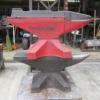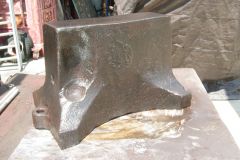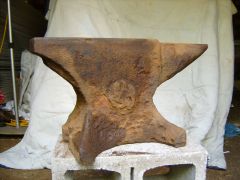-
Posts
2,478 -
Joined
-
Last visited
Content Type
Profiles
Forums
Articles
Gallery
Downloads
Events
Everything posted by njanvilman
-

what type, brand, of anvil is this?
njanvilman replied to BM454's topic in Anvils, Swage Blocks, and Mandrels
The sharp legs look like a Mousehole. Even with the chunk out of the heel, it is still usable. -
"But some folks are but lightly touched with the tool disease; whilst others have it in acute form " I guess I am terminal. Acute ironitis or something.
-

Biggest Fisher Anvil on display
njanvilman replied to njanvilman's topic in Anvils, Swage Blocks, and Mandrels
We both believe that it is a fully functioning anvil, with steel faces. The rust dimples are different on the faces than on the sides. -

Biggest Fisher Anvil on display
njanvilman replied to njanvilman's topic in Anvils, Swage Blocks, and Mandrels
The face plates were cut from 0-1 steel of the appropriate width and thickness for the size anvil being made. The horn plates were cast steel, made from patterns supplied by FN. I have never found out who made the horn castings for them, in any era of their existance. The early Fisher anvils used English 'Jasper' steel on the top. I guess the quality of steel available in US was not of a high enough quality. -
"one has got to go". I do not understand. This has never come up before. Sell? What does that mean?
-

$400 powerhammer is home
njanvilman replied to postleg's topic in Power Hammers, Treadle Hammers, Olivers
The anvil base part of the hammer looks identical to my Hawkeye helve hammer. I will try to get some photos tomorrow and measurements. It almost looks like it was cobbled together from other hammers and parts. -

Biggest Fisher Anvil on display
njanvilman replied to njanvilman's topic in Anvils, Swage Blocks, and Mandrels
I find it interesting that the logo on the 1400 is totally different from any of their other logos. And on the "wrong" side. And no FISHER on the anvil. I have the exact dimensions in my notes in the museum, but I believe the hardy hole is 2 1/2", and the pritchel hole is 1". There are no hammer marks on the face. I do not believe it was ever used for anything except to sit on. -

Biggest Fisher Anvil on display
njanvilman replied to njanvilman's topic in Anvils, Swage Blocks, and Mandrels
The anvil sat outside of the original foundry for about 80 years. Then it sat outside on the owners farm for 15 years. When I found it in 1999, it was white gloves or no touch. I guess they figured that I have the "rust" touch or something. I wore the gloves to measure it and to move it for photos. If you visit my museum, you all have permission to touch, hug or inspect any of my anvils all you want. -
I let the monster out of the cage...I found out the location of the big Fisher anvil back in 1999. It was sitting in a basement vault of the NJ State Museum. How it got there will be in my book. Long story short, after budget problems, rotating curators, a museum shutdown for a few years, I finally made contact with a curator who seems to be staying around. I made an appeal to borrow the anvil to get it to Blacksmithing events, ABANA shows, and the like. In-between I would keep it at my museum collection. Well, now there is interest in it, so they decided to put it in a display of items made in NJ. The exhibit just opened a few weeks ago. Today, I went to visit. They did a nice job of placing the anvil as the first item you see as you enter the exhibit. I had forgotten how big it is. Dimensions, roughly are 60" long, 22" tall, and about 9" face. This is the anvil that was made for the Centenial Exhibit of 1876 in Philadelphia. A picture of the anvil on the top of the Fisher & Norris exhibit is in Postman's book. The 1400 lb weight has never been confirmed by a certified scale. Someday, that will have to be done. The exhibit is on indefinately. Hopefully, they will let me borrow it once the exhibit closes. Who knows. I have included one photo with a dollar bill for scale. The guard took the photo while I held the bill. He would not let me put the bill against the base.
-
Its the real deal. No dead or fake Fish here. It is an 80 lb anvil, with the uncommon Fisher trademark above the base. It is hard to tell if any repair work has been done without seeing it and removing the black paint. But from the pictures, it looks like a nice anvil. The only questionable thing is the cresent shape crack?? or something on the face. Again, one would have to see it and check it out to know what that is. All my opinion from the three photos.
-
THe small anvil on the dolly is a STAR anvil. Has a five point star cast in. Made in Trenton, NJ from 1856 to 1870. Similar to a Fisher, but not exactly.
-

New addition to the Fisher Museum
njanvilman replied to njanvilman's topic in Anvils, Swage Blocks, and Mandrels
The missing chunk is definately a casting defect. It looks like an air bubble or such prevented a complete fill of the iron. It did not affect the top or the integrity of the anvil, so it was marketed. I plan on making swage blocks from the Fisher patterns first. We'll see how that goes then deal with anvils. While in Newport, Maine, I contacted the local historical people and did research on Fisher foundry. Newport is where Fisher first made anvils, from 1843 to 1851. I photographed the possible location of the foundry and copied some historical documents they had in the library. Nice people in Newport. I figured out how to post photos, but not how to make them smaller to fit. Help anyone.... -
I went up to Newport Maine a few days ago to pick up a 263 lb Fisher sawmakers that I had bought. Curious feature, it is the only Fisher style sawmakers with the Fisher mounting lugs. The anvil is dated 1936. It also has a casting defect on the body. Curious that they sold it instead of melting it down. When I got home, I also found that I have the pattern that made the anvil. I will post those photos later.
-
You have a FISHER anvil. Stated weight of 300, but this was subject to +/- about 10%. Your anvil looks to be in decent shape. A few edge chips of no consequence. If there is a date, it would be under the heel. Not all Fishers were dated, especially ones made in the 50s and 60s by the Crossley era. Does it say Fisher on the front base under the horn. If no Fisher, it was probably made in the Crossley era, but it is still a Fisher. Need more information, ask away.
-
I am working with a foundry on another small pattern. When we see how that works out, I might try the 12x12 swage block. All takes time.
-
I left it the way I got it. I think it has most of its original paint on it. The museum is insulated and closed so not much is needed to stop rust. A light wipe down of any light oil on the bare metal does it for a year. First attempt at posting photo. How do I resize it for this forum?
-
Went to Maryland today and picked up a nice 600 lb Fisher anvil. Not cheap, but rare. Put it in my Chevy Trailblazer and it sank 4 inches. Secured it to the trailer hitch in case of sudden stops(did not want to become one with the anvil)with a two inch nylon strap. Home, cleaned up, and on display in the museum. Now only missing the 700 lb anvil. Some day I will find that one.
-

what to do with this anvil.
njanvilman replied to drako's topic in Anvils, Swage Blocks, and Mandrels
The Fisher anvils are cast iron with the face welded on during the casting process. You will not be able to forge weld a new plate on. Do not pry off the rest. The only repair hope is to grind the steel back a bit at the break line, grind the iron top to clean, then preheat the anvil. After that, clean again, and lay down a thick nickel layer with nickel welding rods for cast iron. Then weld several layers of strong steel(I do not recommend any, speak to a welding supply store). Then careful grinding to restore the face. Hardness is not guaranteed. I would never attempt it. A broken top plate is the biggest problem with Fishers. It did not happen often, but it does happen. Fisher offered a one year guarantee on their anvils. It it broke, you had to ship it back to Trenton and they would replace it if it was defective. Obviously, your anvil is long out of warrantee period. And there is a highway going right through the location of the Fisher plant. I have several like yours in my museum. They live in the Fisher graveyard, showing what happens when they die. RIP. -
-
I am eagerly awaiting a report of how the ABANA conference in Memphis went. I know it was HOT. But hopefully a good time was had by all. If anyone stayed for the auction, did you happen to catch what my BIG walnut gavel went for. Hopefully I will get to the next one. Could not get days off from teaching this time of year.
-
Be sure to check out the walnut "Gavel" I made for the conference. I turned the parts, and we created the conference logo on Correll, then engraved the head with the laser engraver. I mailed it off to the ABANA central office Saturday. They might use it for the opening ceremony, and then auction it off on Saturday. It is also signed by me. If anyone is at the auction, could you let me know how much it brings. Thanks.
-

350 Layer Pattern Welded Belt Buckle
njanvilman replied to Jose Gomez's topic in Blacksmithing, General Discussion
Beautiful. Very organic looking, like tree rings. -
Nice work. The lack of hammer marks shows great hammer control.
-

What was the purpose of this anvil?
njanvilman replied to nuge's topic in Anvils, Swage Blocks, and Mandrels
I vote for some kind of weight. Definately not made as an anvil, but will probably work as one.


